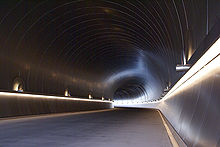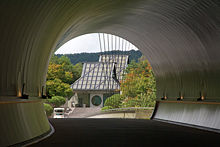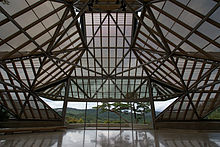Miho Museum
Opened in 1997 , the Miho Museum is located near the city of Kōka in the Japanese prefecture of Shiga , northeast of Kyoto . The museum goes back to Mihoko Koyama (after whom it was named), the heiress of the Toyobo textile company, one of the richest women in Japan. In 1970 she founded the Shinji Shumeikai spiritual movement , which is now said to have 400,000 members worldwide. In 1991 she gave the order to build the museum near "Misono", the spiritual center of Shumei , in the mountains of Shiga.
collection
The Miho Museum exhibits Mihoko Koyama's private collection of Asian and Western antiques , as well as other exhibits allegedly valued at between $ 300 million and $ 1 billion that Shumei bought on the world market until the museum opened in 1997. The collection comprises a total of 2,000 exhibits, around 250 of which can be seen.
architecture
The well-known architect Ieoh Ming Pei had previously built the bell tower in "Misono", Shumei's international headquarters near the Miho Museum. Mihoko Koyama and her daughter Hiroko Koyama then commissioned Pei to build the Miho Museum as well.
80% of the 17,400 square meter building is built underground into the mountain. According to a requirement of the local authorities, only a limited area was allowed to be visible from the outside. As the collection grew during the construction phase, the project was expanded and ultimately more underground space was built than originally planned. The roof is made of a glass and steel construction, while the walls are made of beige Magny Doré limestone from France - the same material that Pei also used for the reception building of the Louvre .
The way to the museum leads to a tunnel entrance. You can cover this route with the museum's electric vehicles. The tunnel is about 200 meters long and slightly curved so that the exit is not initially visible. At the other end, the tunnel opens into a half-suspension bridge that spans a 100-meter-deep gorge. The passage through the tunnel is intended to symbolize entering another, paradise-like world ( Shangri-La ). The bridge leads into a small forecourt, from which a few steps lead up to the entrance of the museum. This small staircase resembles the typical stairway to Japanese temples .
In 2002 the museum bridge received the “ Outstanding Structure Award ” from IABSE .
Web links
Coordinates: 34 ° 54 '52.6 " N , 136 ° 1' 22.4" E
Individual evidence
- ↑ The old man and the mountain . In: Der Spiegel . No. 48 , 1997, pp. 247 ( Online - Nov. 24, 1997 ).



